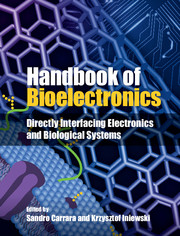Book contents
- Frontmatter
- Contents
- List of Contributors
- 1 What is bioelectronics?
- Part I Electronic components
- Part II Biosensors
- Part III Fuel cells
- Part IV Biomimetic systems
- Part V Bionics
- Part VI Brain interfaces
- Part VII Lab-on-a-chip
- Part VIII Future perspectives
- 40 Future perspectives in bioelectronics
- 41 Real-time activity energy expenditure estimation for embedded ambulatory systems using Sensium™ technologies
- 42 Electronic systems for health management
- 43 Linking the cyber and biological worlds: the Ensemble is the Function
- 44 Conclusion: Personal electronics and distributed theranostics
- Index
- References
43 - Linking the cyber and biological worlds: the Ensemble is the Function
from Part VIII - Future perspectives
Published online by Cambridge University Press: 05 September 2015
- Frontmatter
- Contents
- List of Contributors
- 1 What is bioelectronics?
- Part I Electronic components
- Part II Biosensors
- Part III Fuel cells
- Part IV Biomimetic systems
- Part V Bionics
- Part VI Brain interfaces
- Part VII Lab-on-a-chip
- Part VIII Future perspectives
- 40 Future perspectives in bioelectronics
- 41 Real-time activity energy expenditure estimation for embedded ambulatory systems using Sensium™ technologies
- 42 Electronic systems for health management
- 43 Linking the cyber and biological worlds: the Ensemble is the Function
- 44 Conclusion: Personal electronics and distributed theranostics
- Index
- References
Summary
Introduction
Mark Weiser in 1991 set the vision for ubiquitous computing: “The most profound technologies are those that disappear. They weave themselves into the fabric of everyday life until they are indistinguishable from it.”[1]. Ubiquitous computing in his vision is embedded in the world around us or over our body via sensor networks accessed through intelligent interfaces: “Its highest ideal is to make a computer so embedded, so fitting, so natural, that we use it without even thinking about it.”[2]. He meant to reposition the center of our world by moving towards human-centered computing, where technology assists us adapting to human needs and preferences while remaining in the background, silent until required. Weiser predicted three ages of computing technology: the mainframe age when many people shared a computer; the personal computer age when one person has one computer; and the ubiquitous computing age when each person shares many computers via a rich interconnect fabric. The consequence of this evolution of computing is a change in how people can interact with technology: a more natural way of using the power of networked sensing and computing systems. In the ubiquitous computing world, people are connected not just to the Internet or other computers, but to places, other people, even to everyday objects and things. Indeed the frontier of research is very much related to this vision: Internet of Things, Systems of Systems, and Swarms are all different facets of this encompassing vision, albeit each theme emphasizes one particular aspect.
The increasing maturity, performance, and miniaturization of processors, networking technologies, memory, displays, and sensors is enabling a move towards pervasive computing, ubiquitous connectivity, and more adaptable interfaces that are sensitive and responsive.
- Type
- Chapter
- Information
- Handbook of BioelectronicsDirectly Interfacing Electronics and Biological Systems, pp. 550 - 564Publisher: Cambridge University PressPrint publication year: 2015

